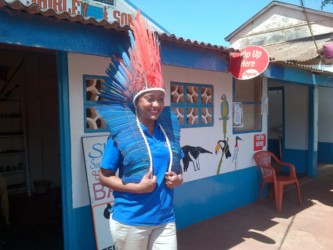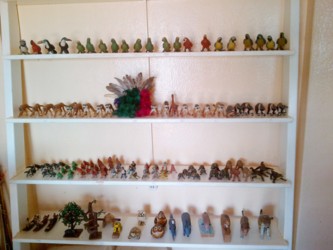Water tumbles over the ancient brownish-gray rocks of the Kumu falls in a never-ending white spray, splashing on the Portuguese-speaking tourists, swimming in the clear, cold stream at the bottom.
The dozen people here on Sunday afternoon last week are a mixture of Brazilians from Bom Fim and Guyanese from Lethem. In this community, where the Rupununi savannahs meet the forest at the foot of the Kanuku Mountains, the falls are a growing attraction with an average of 50 visitors arriving on weekends

to splash in the cold waters and cook and drink in the jungle clearing.
“I’m trying to build a really good foundation before I start a resort,” said Peter Joseph, who manages the falls, keeps the footpaths clear and calls the jungle his office. In the deepening dusk, he points to the nearby Schomburgk’s peak, the highest mountain in this part of the Kanuku range and said that the rare cock-of-the-rock courts the females on the flat rocks on the peak and visitors who make the day-long trek always get to see them.
There are other waterfalls in the area that are slowly being developed as tourist attractions and Joseph said that in recent times, the number of visitors has been increasing.
The attractions of the Rupununi are many and varied. The rolling savannahs, the wetlands and forested mountains where endangered species are not so rare; the indigenous cultures, the vaqueros of the South Rupununi and anthropological sites have been attracting tourists for many years and while no hard figures are available for the region, anecdotal evidence and increased promotion suggests an increase in visitors in recent times.
With the region’s strong leaning to eco and adventure tourism, the non-governmental organisation, Conservation International (CI), believes that this form, where tourism is done in a sustainable manner so that local communities benefit and the environment is protected, could be one of the pillars of future development of the Rupununi.
With funding from the Inter-American Development Bank (IDB), CI is working with local communities and tourism operators on a US$1.6 million project meant to improve livelihoods using a low carbon pathway. Under the ‘Leveraging Natural Capital in Guyana’s Rupununi – Improving livelihoods through low carbon economic development of the Rupununi’ project, CI hosted a seminar in St Ignatius last week where the Rupununi tourism product, the challenges and needs as well as possible solutions were highlighted and explored by players from across the Rupununi. The project also focuses on sustainable agriculture.

Among the aims are the linking of Community-Based Enterprises (CBEs) with larger private sector firms, government agencies, service providers and non-governmental agencies (NGOs) as well as designing and piloting of innovative low-carbon and climate-resilient community-based tourism and agriculture business models, through training, capitalisation of ecosystem value and enhanced ability to access higher value markets and finance. A Rupununi Innovation Fund where eligible projects can access funds will also be established.
For such projects, the community aspect is important, project manager, Rene Edwards emphasised. “It must have economic benefits, it must have social benefits and it must not impact on the environment in a negative way,” he said.
The Rupununi is an untold story, chairman of the Project Steering Committee Major General (retd) Joe Singh said. “Let us take the time to study and inform ourselves because visitors just don’t want to climb mountains…they [also] want to hear about the history of the place,” he said.
For many visitors, Lethem, the administrative capital of the Rupununi, is the first stop and tour operators emphasised the need to keep the booming community clean. A rudimentary garbage collection is available but given the piles of half-burned garbage on roadsides and empty lots, it is evident that many do not use the service and operators said that this problem needs to be nipped in the bud lest Lethem becomes “another Georgetown”.
The need for an information booth at the airport was also highlighted while standardising fares of taxis, which are the only form of public transport within Lethem, was also urged.
President of the Rupununi Chamber of Commerce and Industry (RCCI) Daniel Gajie acknowledged that there are some things that need to be boosted to make Lethem a better hub. He also pointed to the advantages it enjoys as compared to the rest of the region such as being a legal port of entry, the banks, shopping, medical facilities, communication facilities, hotels, restaurants, and access by road and air.
Many Brazilians visit Lethem, which lies on the border with Brazil, to shop and travel onwards to Georgetown and Leila King, Guyana’s Consul General in the closest Brazilian city, Boa Vista, emphasised that air transport is important. She suggested direct Boa Vista to Georgetown flights or at least an upgraded airport at Lethem. Gajie recommended lobbying for the Lethem airstrip, which he said has the second longest runway in Guyana, to become an international airport. He also noted the need for the establishment of a bus terminal for transport by road.
Outside of Lethem, trained guides and the need for duty-free concessions for vehicles and boats was highlighted. Bureaucracy and the lack of incentives were also identified as challenges.
There are many opportunities for the growth of tourism in the Rupununi, operators agreed. “We are unknown in the world,” said Wayne Mann who operates a restaurant and bar and targets backpackers and has plans for a back-packers hostel. Kayla De Freitas of Rupununi Trails, the only tour operator in the South Rupununi, highlighted the attractions of the area such as boating, jaguar-spotting and participating in the cowboy culture of what was once one of the largest ranch in the world. In this wild region with no paved roads, transport is by four-wheel drive vehicles or boats but it is difficult to get duty-free concessions, she said.

The high cost of transportation into and around the region is one of the major impediments to tourism in the Rupununi, according to several operators. “If the roads are better, then the transportation cost will be cheaper,” one operator said. “Road improvement will mean less wear and tear, less gasoline, less everything.” It was noted that miners receive a fuel subsidy and it was suggested that how the tourism sector can access this concession be explored.
Natoyah Fields of the Guyana Tourism Authority said that her organisation plans to do some training for tour operators in Lethem and said that the setting up of an information booth at the Lethem airstrip will also be considered.
Despite the challenges, many of the operators, including indigenous communities such as Surama are forging ahead with their product and others are working to make the tourist experience easier. Last year, Rupununi Adventures produced the first tourist map of Lethem. “Tourism is definitely getting in the grains in the Rupununi in a new way now,” said Shirley Melville. She said the seminar takes the discussion to another level where people are starting to do more networking and look at the sector from a regional perspective. There are also new opportunities that operators could cash into, she said.
With Brazilians coming over the border daily to shop, head to the coast or just for a soak at the falls, Lethem, which also hosts the popular Rupununi Rodeo at Easter, receives the majority of visitors. In this dusty town, paved roads are now appearing and the number of hotels is slowly increasing while the number of stores as well as flights by small local airlines has boomed. The number of tour operators has increased and local indigenous communities such as Katoka are getting into the sector.
In a little kiosk just off the second-longest runway in Guyana, the ever-jovial Melville charms visitors into her souvenir shop filled with local balata craft depicting local animals such as the jaguar and parrots as well as jewellery made out of local materials and even hand-made cotton hammocks. Prices are reasonable. But even if you don’t buy, you can try on the authentic chief’s headdress from the Wai-Wai’s deep in the southern jungle of Guyana. “Smile,” Melville urges, lightly dismissing a thought that chiefs are expected to be serious. “Chiefs smile.”





